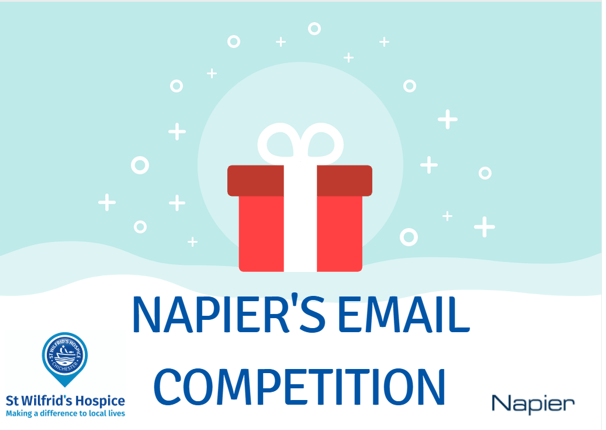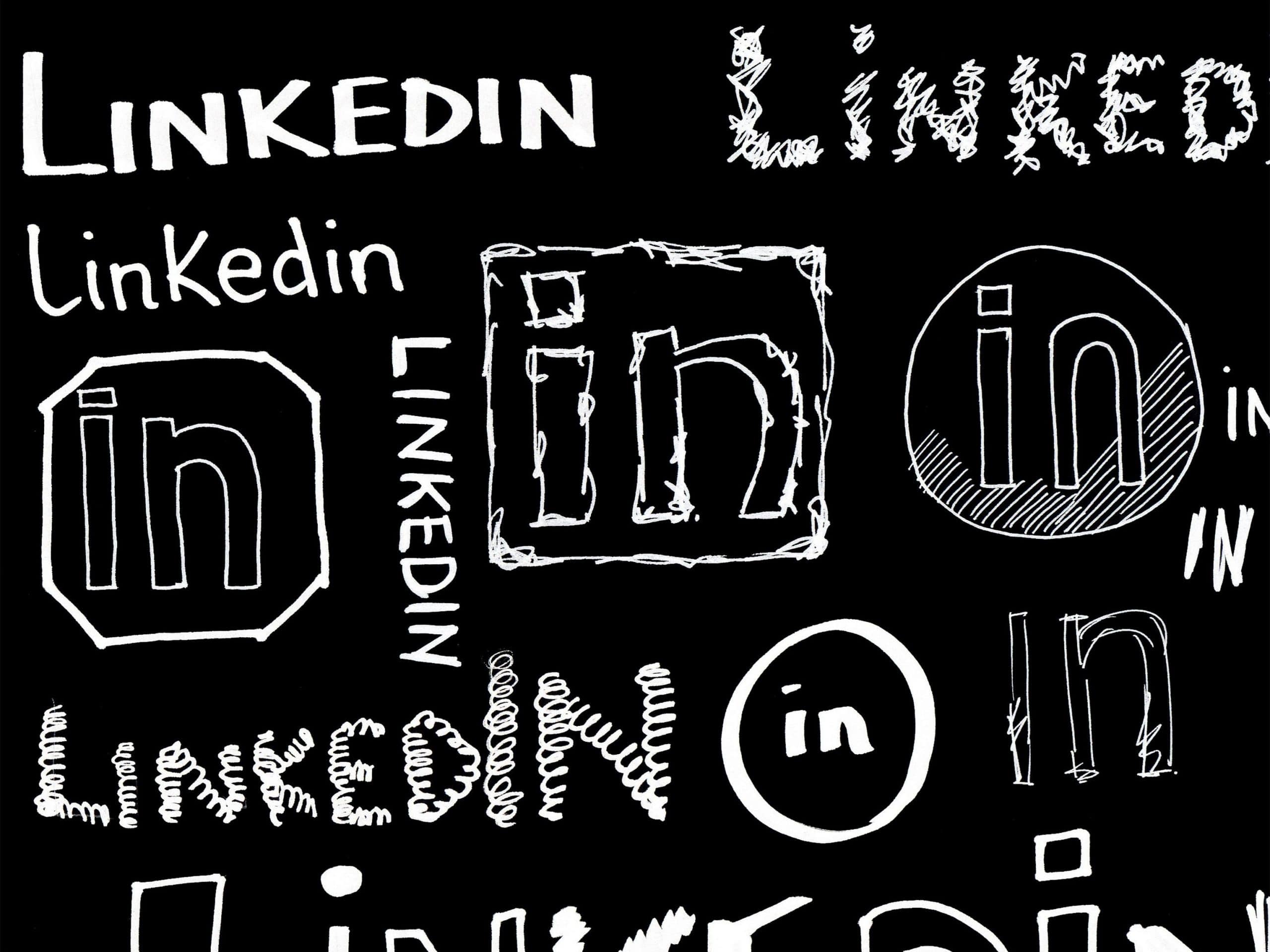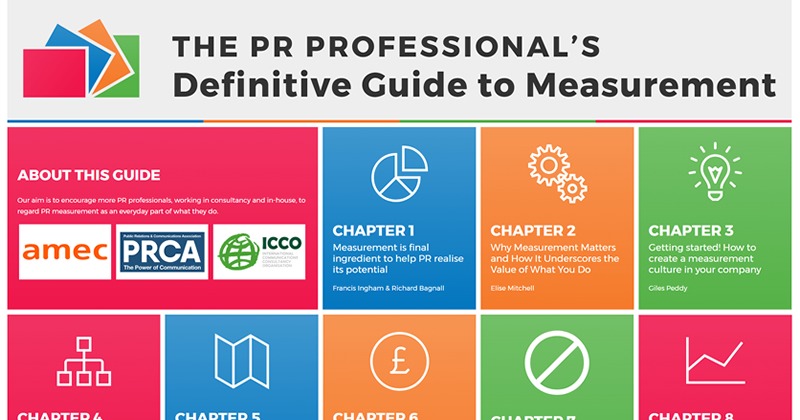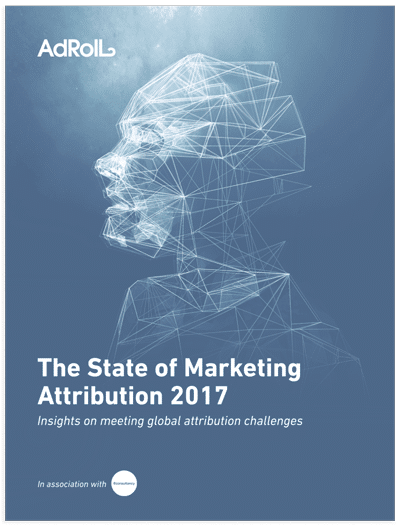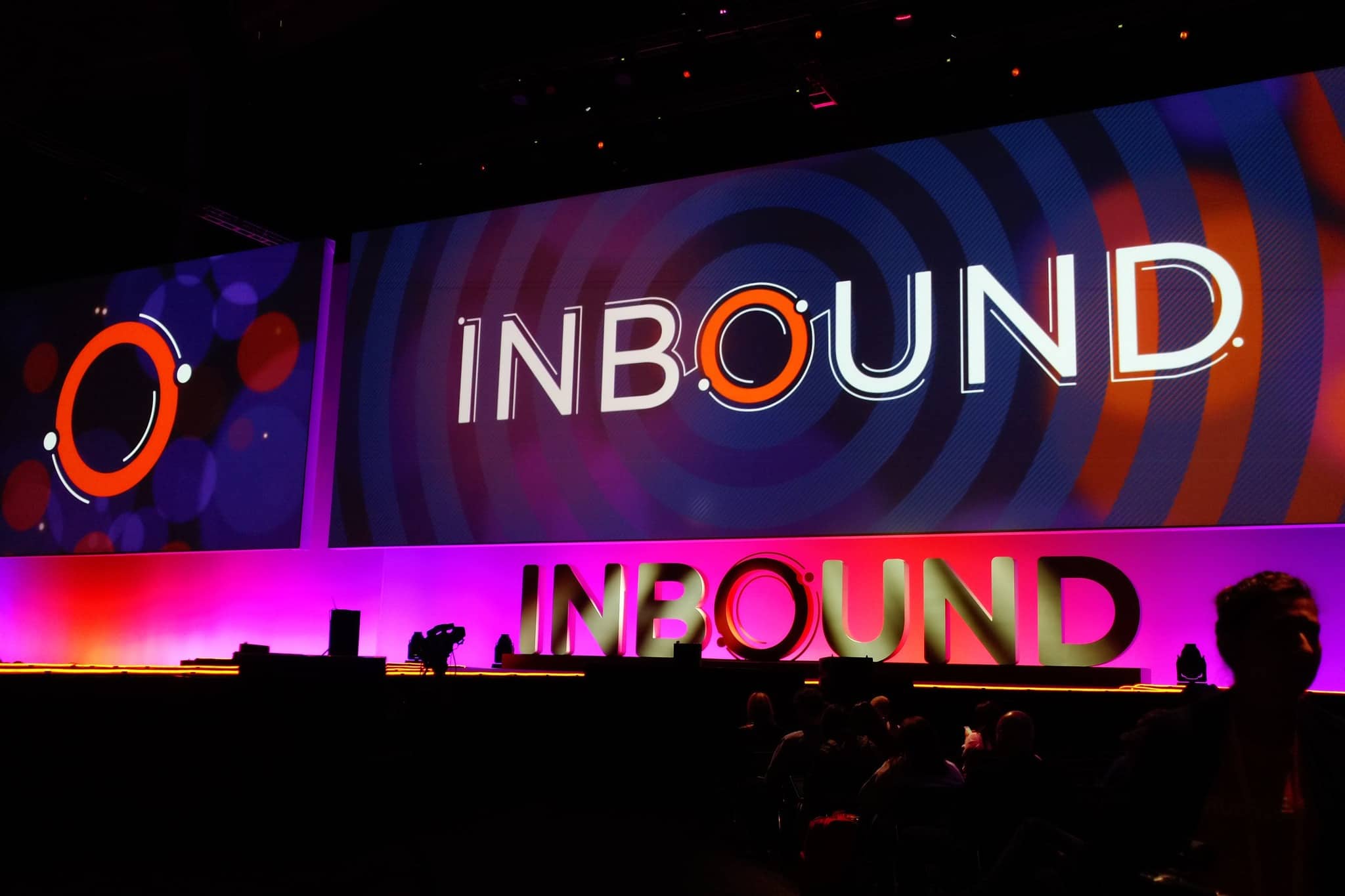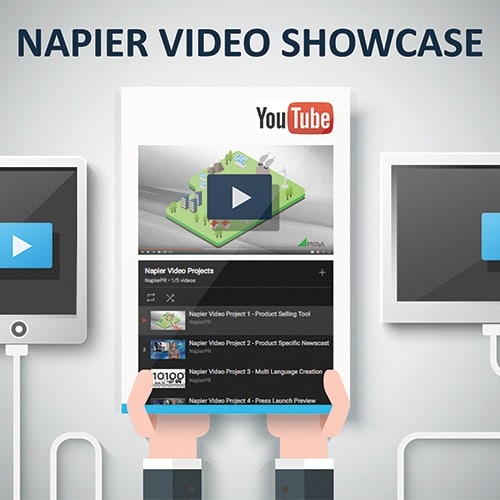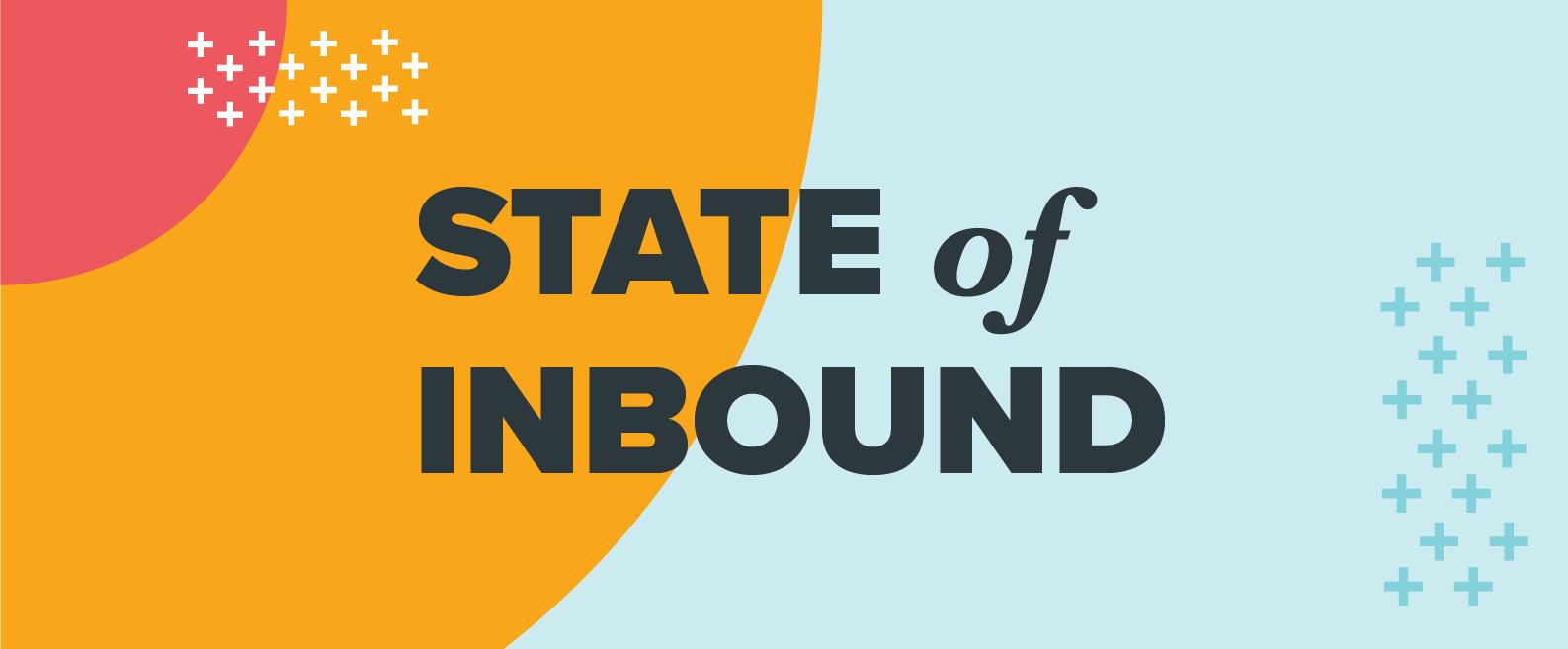INBOUND Taught Me: How to Win in the ever-evolving world of Social Media
During the time we spent at the HubSpot INBOUND Conference 2017, we attended partner day. As proud partners of HubSpot, we joined other agencies for the day, where we learnt the latest news about HubSpot features, and attended special sessions, not available during the 3-day main event.
One session that stood out, and stuck with me was the ‘How you can Win in the New, Ad Powered, Video Driven, Ever Evolving World of Social Media’. Although a mouthful, the session covered many valuable points; offering advice on how you and your clients can stay ahead with Social Media, and how HubSpot has rethought its approach to social, to lead a new and more modern charge alongside their customers.
Daria Marmer from HubSpot, and Ali Parmelee and Dawn Barson from THINK Creative Group, were the key speakers throughout this session. Drawing from their own experiences, they discussed amongst themselves and to their audience about the way to approach campaign strategies with social in mind. The tips and information provided throughout this session is what I will share with you throughout the rest of this post.
Tips for Successful Social Media Posting
Whether we are aware of it or not, social media is beginning to drive and lead our campaign strategies, and with 30% of the world’s population on Facebook, companies are now selling their products through social media sites. Although organic reach on Facebook is very low, whether this is video, images or text. Paid traffic including banner ads, sponsored posts and boosted posts has been proven to be very successful.
The one problem companies are facing by selling through social media sites, such as Facebook, is that networks want people to stay on the platform rather than being redirected back to a website. There are many ways for companies to achieve this, by posting videos, or specific content, allowing companies to be able to target or retarget their audience without necessarily leading them back to their website.
Video has only become more important over the years, and today it is included in many campaign strategies, as it is considered greatly beneficial, whilst helping companies engage with their audience. Research has revealed that companies receive great engagement from their audience with videos up to 2 minutes, but often see a decrease in views in videos that are between 2 to 6 minutes long. Surprisingly, research has also revealed that the second ‘sweet spot’ where companies have seen increased engagement in videos, is between 6 to 12 minutes.
It seems the results for video engagement can vary, and often the best solution is to test, test and test again. Facebook Live is a good way to test engagement of video, and clients have previously been surprised to see how many people actually stay till the end of the video.
With 82% of Facebook’s revenue from mobile phones, a drastic difference from 10% in 2012. Companies also need to be aware of creating mobile ads which can successfully attract and engage their audience. Luckily, changes are being made to make mobile ads more effective for the B2B industry.
HubSpot and Social Media
As promised, HubSpot has rethought its approach to social, leading their buyer journey alongside their consumers social strategy. For example, when pairing their buyer journey with the Inbound approach and Facebook Ads, it presents a successful plan to ensure potential consumers convert. As you can see below, (a photo of a slide shown in the presentation) video ads, brand awareness, reach and traffic are all components of the attract stage, which are top of the funnel content and draw in strangers to look at your products.
HubSpot also presented a significant awareness in improving and paying more attention to the delight stage of their funnel. The use of the delight stage in the buyer funnel, partnered with a social media strategy, means converted customers can turn into promoters by writing reviews, or talking about their customer service online.
ROI Calculator
The HubSpot calculator has also been recently introduced, a new and beneficial tool for many B2B marketers. This ‘calculator’ was established to help marketers work out their advertising ROI. By inserting key figures such as your projected monthly budget and your expected CPC, marketers can work out an estimated return on their ad spend. This is key to HubSpot’s new approach to social, as they offer the opportunity for their consumers to take less risk when it comes to their social media strategy, as they can now work out the ROI for specific ads, such as key Facebook ads.
At Napier, we created our own version of a ROI calculator, why not try it out for yourself?
A step up with Instagram...
HubSpot also revealed a new publishing feature for their HubSpot social tools. As Instagram has become larger and more popular, the platforms influence is beginning to create a significant impact in the B2B sector. Following this rise in popularity, HubSpot has introduced a new feature called Instagram reminders.
This feature will allow customers to create and schedule photos and videos on the HubSpot platform. When the time comes to publish, a notification will then be sent via the HubSpot mobile app, and from there you can open the app, copy and paste the text into Instagram and publish. As Instagram does not allow direct publishing from a third-party to their network, HubSpot has introduced the next best step to handling the demand of Instagram, something many marketers were pleased to hear, and are looking forward to when this goes live.
HubSpot Leads Ad Integration
The final and arguably most noteworthy reveal of this session, was the announcement of the lead ad integration with Facebook. This update brings Facebook lead ad creation, tracking and lead sync to both HubSpot marketing free and paid. The integration is exclusive to Facebook lead ads, which were specifically built for an B2B audience.
The ads feature a strong CTA and use Facebook data to auto populate forms; and with the integration installed, immediately send leads to HubSpot. These lead ads are shown to the most relevant audiences across Facebook desktop, mobile app and Instagram. This integration not only offers a new and improved way to capture leads through Facebook, but also creates a place for the leads to land together and quickly be converted through HubSpot.
Why not take a look at other posts in our INBOUND 2017 Series?
- The Top 15 Things We Learnt at INBOUND 2017.
- INBOUND 2017 Taught Me: The Importance of Look-alike Campaigns
- INBOUND 2017 Taught Me: Topic Clusters
- INBOUND 2017 Taught Me: HubSpot Finally Reveals the Secrets to Achieving Explosive Success on LinkedIn
Napier’s latest Challenge – A Email Competition for Charity
*Competition Now Closed*
At Napier, we are a team of individuals who often jump at the chance for a challenge; and with Christmas fast approaching we decided to create a challenge with a twist, that would not only showcase our skills but also make sure we do our part and donate to charity.
Email marketing is an essential part of any marketers B2B strategy, with emails being the key way marketers make contact with their audience. At Napier, we are constantly testing out our own email designs, or helping our clients design and deploy their emails. We understand that every marketer is different, and they often have their own preferences when it comes to emails and their layout.
In light of this, we thought it would be interesting to run a competition, inviting professionals in the B2B Tech industry to decide which email design out of a choice of 3 they preferred.
With the challenge set, the next big step was deciding on the focus of these emails. We decided to take a unique direction, and test our skills by creating email designs for a local charity. St Wilfrid’s Hospice was an obvious decision, a local charity in Chichester who care and support people who are in the last phase of their life. As an agency, we also decided to do our part, donating to St Wilfrid’s as a thank you for letting us use their brand and promote their message.
Napier’s’ very own Fiona Challen, Emily Serna and Hannah Kelly took part in this challenge, with a brief to create an email that encourage new donors to donate over Christmas, as well as pass on the request or share their donations on social media. Voting will close on the 8th December and Winners will announced on the 11th December.
Each has taken a different direction with their email and it is now up to you to decide which one you think is the best:
Email 1:
Email 2:
Email 3:
HubSpot announces Data Centre in Germany
HubSpot has further proved its commitment to Europe this year, by not only opening a new Berlin office, but also announcing a new Germany based data centre for 2018.
HubSpot's findings from a recent survey has identified Berlin as the fastest growing tech city in Europe, with a vast majority of respondents positioning the city as a growing hub for startups and tech companies.
The survey was conducted on consumers who live and work in the Berlin Metro area, and a massive 95% of respondents confirmed that they see the number of technology jobs in the city growing; whilst 90% said Berlin also offers access to the technology and digital talent needed to grow a tech company.
As Berlin continues to grow, it is no surprise that HubSpot has decided to place roots in the city. President and COO of HubSpot, JD Sherman stated "Opening an office in Berlin is a smart choice – from the wealth of local talent to its growing digital infrastructure, the city offers a great opportunities for us to continue HubSpot’s growth across Europe".
The announcement of the opening of a Germany-based data centre in 2018, also strengthens HubSpot's foothold in Berlin, with the company to rely on a facility in Frankfurt to store customer data according to EU legislation. The new data center will provide redundancy as well as outage and data protection for HubSpot customers. Both marketing automation and HubSpot are doing well in Germany and this is one of the reasons why Inbound marketing is a great way to run permission-driven campaigns.; and with HubSpot's new announcements this is bound to continue being successful.
With this being the 2nd European office HubSpot has opened, it is clear to see that HubSpot are serious about proving their commitment to Europe. As the company continues to grow, they provide benefits to Berlin also, promising to create 75 new jobs over the next three years to meet the rising demand for HubSpot’s software solutions in, and the rapid growth of the DACH market.
INBOUND Taught Me: How to Overhaul Lead Nurturing and Double Conversions
Throughout my time at INBOUND 2017, I spent a lot of time listening about HubSpot’s (rightly so) ‘awesomeness’. This is why it was almost refreshing to attend a presentation where HubSpot admitted to their mistakes, and presented to us a journey of how they overcame their challenges.
The presentation in question was held by HubSpot’s very own Senior Marketing Manager Laurie Aquilante, who discussed the challenges HubSpot faced within their marketing funnel, and how they re-invented their approach to overhaul lead nurturing and double their conversions.
Laurie explained how HubSpot were failing with their lead nurturing. They were overloading prospects with too much information and were not achieving the high number of conversions they were aiming for. To gain a greater sense of what they were doing wrong and how to improve, HubSpot narrowed down their problems to three main challenges to overcome:
- HubSpot’s lead nurturing content was too educational. They were so busy promoting educational content, that most of their prospects didn’t realise that HubSpot sold software.
- HubSpot were failing to move people along their buyer’s journey.
- At no point in the funnel did HubSpot introduce a human connection.
With these challenges in mind, HubSpot decided the best way to move forward was to collect information about their prospects first. They formed a survey which asked their audience what they wanted, when they wanted to be approached in the funnel and what could help their experience.
By collecting this information, HubSpot essentially ‘got to know’ their prospects, and were finally equipped with the right information to attract their audience. The survey revealed that their prospects wanted to speak to a salesperson at the consideration stage of the buying process, while 61% of respondents believed their customer experience could be more positive if sale representatives provided more relevant information.
Equipped with these new insights, HubSpot made changes to not only overcome the challenges they were facing, but also their approach on how to nurture prospects through their marketing funnel.
HubSpot made three key changes to their approach:
- They introduced a human connection. HubSpot introduced ‘Edward Gahr’ an Inbound Growth Specialist, an expert who answered questions and provided faster replies to prospects. This achieved an increase of an 40% conversion rate.
- They personalized based on need. Rather than guessing what their prospects were interested in, HubSpot actually asked what marketing or sales challenges their prospects were facing. Through one simple email, which guided HubSpot to provide the right content to the right person; a 50% increase in workflow conversions was seen, and 172% increase in higher engagement.
- They found new ways to connect with their audience. HubSpot offered their audience a chance to sign up to a webinar through Facebook messenger by their HubSpot chatbot. This saw an increase in engagement between HubSpot and their prospects, with many praising HubSpot for the original way they were connecting with their audience.
Conclusion: Even HubSpot can Improve Lead Nurturing:
It is comforting to realise that even HubSpot has made errors along the way, and that attaining the ‘perfect’ way to achieve successful lead nurturing, takes practise and hard work. From this presentation, I learnt that overhauling leading nurturing and doubling your conversions isn’t easy. But if you understand your buyer intent and fit, provide helpful education, and test, change, and test again; you’re definitely heading in the right direction to achieve it.
Why not take a look at other posts in our INBOUND 2017 Series?
- The Top 15 Things We Learnt at INBOUND 2017
- INBOUND 2017 Taught Me: The Importance of Look-alike Campaigns
- INBOUND 2017 Taught Me: HubSpot Finally Reveals the Secrets to Achieving Explosive Success on LinkedIn
- INBOUND Taught Me: How to Win in the ever-evolving world of Social Media
The DPN Release Guidelines to Justify Processing of Data under the GDPR
The Data Protection Network (DPN) has released guidelines around the use of Legitimate Interests to justify processing of data under the EU’s General Data Protection Regulations (GDPR). These guidelines have been supported by the UK Information Commissioners Office and the Data Protection Commissioner of Ireland, but as we’re not lawyers please do take proper legal advice (although we can’t believe anyone would really trust legal “advice” from a PR agency).
The GDPR has set out 6 lawful grounds for processing personal data. Along with consent, one of the most important grounds is the “Legitimate Interests”. As one of these legitimate interests is processing data for direct marketing purposes, this is an important topic for marketers.
Although processing can be necessary for the legitimate interest pursued by the controller or by a third party, there are interests which can be overridden by the interests or fundamental rights and freedoms of the data subject. So it’s not possible for an organization to simply cite direct marketing as a legitimate interest and carry on processing data for this purpose without any impact from the GDPR.
There are 3 stages that organizations must go through to assess whther a legitimate interest applies:
- Assess whether the legitimate interest exists
- Establish whether the particular processing activity is essential for the pursuit of the legitimate interest(s)
- Perform the balancing test to decide whether a particular processing activity can be undertaken on the basis of the legitimate interest’s condition.
Transparency is also a key part of the GDPR. So even if a legitimate interest applies, organizations must fulfil GDPR’s enhanced transparency requirements: they must inform individuals when the process is being undertaken on the basis of legitimate grounds and what they are. The individual(s) then have the right to object to any process being undertaken on the basis of the legitimate interests’ condition. The DPN has suggested taking a more layered approach, with a click through to a more detailed information on the legitimate interests ground. It was then suggested that more innovative businesses may want to take advantage of privacy enhancing tools, such as adding branded logos, videos and dash boards.
Although more businesses are focusing on the legitimate interests ground to justify certain activities as consent is hard to obtain under the GDPR, legitimate interests grounds still requires a careful thought process and it’s important to document the analysis as part of an organizations compliance story.
Each individual still continues to have the right to object any personal data being used, and although businesses may be able to override this on the basis they can show compelling legitimate interest it’s unlikely that direct marketing will trump an individual’s objection. So it’s essential to allow subjects to opt out easily, and provide capabilities to erase their data.
The GDPR have suggested that organizations should all aim to process data for activities that are in a controller’s or a third parties legitimate interests and benefit individuals. The orgnaisations should explain the benefit to the data subjects; for example to ensure that they are shown adverts for products or services they might be interested in. Organizations need to positively enable individuals to choose not to have their personal date used in a certain way, such as brand friendly privacy dashboards. They should also ensure they have the technical means to act on an individual’s objection.
Disclaimer: We’re not lawyers, so please do not take any of this information as legal advice. Hopefully it gives you some ideas, but please do consult with trained legal professions, particularly as it looks like some of the GDPR will be open to interpretation by the courts.
INBOUND 2017 Taught Me: HubSpot Finally Reveals the Secrets to Achieving Explosive Success on LinkedIn
Throughout my time at INBOUND, I attended several conferences surrounding a variety of subjects. This varied widely from ABM to lead nurturing, and although admittedly a few of these conferences were slowly forgotten, there were many which made a significant impact.
This included the presentation on creating explosive success with content marketing on LinkedIn. Undeniably I did arrive slightly skeptical, wondering whether this talk would be truly helpful, or spout the same thing we’ve all heard before. In fact, I was amazed at how helpful and informative the presentation was, and I left with a whole new view on how to approach content marketing on LinkedIn in the future.
The presentation in question was held by Viveka von Rosen, co-founder and Chief Visibility Officer of Vengreso, the largest full spectrum digital social selling provider in the world. Viveka is also known as a contributing expert on LinkedIn, with over 10 years of LinkedIn experience.
Viveka began with the obvious, highlighting how LinkedIn publisher helps build engagement, and revealing the most popular type of content people share on LinkedIn. These included:
- ‘How to’ Posts
- Posts with ‘Tips’ in the Title
- Top Ten Lists
- Research Focused Posts
- Infographics
This type of content encourages the audience to share, read and most importantly take notice. A new feature on LinkedIn has also increased the chance of engaging your audience, with the announcement of the LinkedIn video feature. Although it is only available via mobile phone, this new feature is bound to increase engagement, not only within the B2C sector but the B2B industry as well.
After this encouraging news, I sat with my pen in hand, ready to learn the tips needed to improve our content marketing on LinkedIn, and more importantly how to implement them to ensure success.
Customize your Content
Customizing your content is vital to engaging your audience. Without knowing the interests of your targeted audience your content could be missing all the right spots.
Correcting this is simpler than it may seem, by purely asking what your audience wants. Whether this is through an update, email, or on your social media channels, this is a good way to grasp what content your audience is searching for.
Fortunately, this doesn’t mean all content needs to be created from scratch. Often existing content can be altered or updated and used again, a clever way to get the content you need uploaded on LinkedIn as soon as possible.
Article Writing
When publishing on LinkedIn publisher, it can be hard to know whether your article is going to be a success. These tips will ensure you will never have to worry again:
- Larger articles with words between 500 – 10,000 are in fact the most popular.
- E-books are a big hit on LinkedIn, with bigger articles published having achieved more success.
- Call-to-actions are vital within an article. They give clear guidance to the reader of where they should go next or where they can learn more.
- Use Cohesive and Strong visuals. This will instantly draw attention to your article.
- An additional bio at the bottom of your article is significant. Providing information about yourself and your company, means you offer crucial information to your audience, making it easy for them to contact you with any questions.
- Post your article on LinkedIn Publisher but also as a normal LinkedIn post. By changing the introduction and conclusion on one post, you technically have two different pieces of content which gets double the exposure.
Share, Share, and Share Again
HubSpot also revealed a ‘Ninja Trick’ for achieving explosive success on LinkedIn for content marketing.
One of the main benefits of LinkedIn, is that there is no limit to the amount of times you share your posts. One of the best things you can do for your content is share and then share again. For both articles and normal posts, it is highly recommended to share as many times as you see fit.
The sharing doesn’t have to stop there though. On LinkedIn once you have published your article, you can click on the article and copy the URL from the pop up window. This allows you to take the URL to other social networking sites such as Twitter and Facebook, and promote your article through posts on these sites.
This ‘Ninja Trick’ provides the opportunity for you to increase the awareness of not only your content but also your company and what you represent.
To Conclude…
At Napier, we take immense pride in our LinkedIn page, and work hard to ensure we are continually improving. After attending the HubSpot INBOUND event, and in specific this fantastic presentation, we are excited to begin putting these tips into practice and watch the Napier LinkedIn become even more successful.
Why not take a look at other posts in our INBOUND 2017 Series?
- The Top 15 Things We Learnt at INBOUND 2017.
- INBOUND 2017 Taught Me: The Importance of Look-alike Campaigns
- INBOUND 2017 Taught Me: Topic Clusters
- INBOUND Taught Me: How to Win in the ever-evolving world of Social Media
Vector's Anna Barcelos - Marketing Expert Interview
Anna Barcelos, Director of Marketing at Vector Software, is the latest marketer to have been interviewed for our marketing expert series. As a marketer who has more than 25 years of experience in marketing, we were looking forward to getting to know Anna a bit better; asking her a range of questions:
- What do you like to do in your spare time/hobbies?
I am a very family-oriented person and spend a large portion of my time taking weekend trips to games to watch my son play football. My daughter is currently a senior at high school and so we are also using up a lot of time looking at colleges.
For myself, I like to keep healthy and try to go kickboxing at least 3 times a week. I also like to keep up on technology trends and read as much as I can.
- What football team do you like?
I am a huge fan of the Real Madrid team. I was born in Portugal in the same town as Cristiano Ronaldo, and soccer was always on while I was growing up, so I definitely root for the Real Madrid team. But out of loyalty, as someone who lives in New England I am also a big supporter of the Patriots for “American football.”
- What other career would you have chosen if you weren’t in marketing?
I have been a “purebred” marketer since day one, and have enjoyed over 25 years of experience in marketing, as it has been continually changing and evolving. However, if I was to choose another career I would want to be a data scientist.
Data fascinates me, and I love the notion of collecting huge amounts of information, and taking this information to be analysed and manipulated in order to create different models that could help companies become more successful.
I would have also liked to be a software developer. At the moment, it’s all about software and the importance of this career is only going to increase with time. Ideally, I would double major in both subjects to become a data scientist and a software developer.
We also asked Anna a variety of marketing questions, looking to find out Vector's biggest marketing challenge, as well Anna's future insights and opinions of effective marketing activities and best campaigns:
- What do you think have been the biggest changes to B2B marketing in the past 3 years?
In the past three years, data has become more and more prominent, with marketing automation tools allowing companies to take advantage and find ways to utilise data. The increased use of intelligence data and automation tools to create personalized experiences along the customer journey, is one of the biggest changes I’ve seen to B2B marketing.
I recently read a great report done with Google* which explored how leading brands are investing in a “first-party” future, that is using the data they’ve collected on their customers and creating individualized experiences. Within the report there is a discussion on artificial intelligence and the impact it will have on marketing in the future. The report proposes that the use of artificial intelligence through machine learning will grow, to more accurately predict and provide customers with instant, personalized experiences along their buying journey. As a marketer myself, this is something I fully agree with and what I see for marketing in the future. Exciting!
*An Audience of Individuals, 2017 Econsultancy and Google
- What do you think will be the biggest change in the way you approach your campaigns in the next 3 years?
In the next 3 years, I believe the biggest change in the way we approach our campaigns will be through our marketing expertise. Having people with digital capabilities who can create these online strategies will be essential. With the increase in data and the need to utilise it, we need data-driven people who are a cross between marketers and data analysts.
The challenge will lie in trying to find the people who have this added layer of expertise, as well as the resources to create and implement these campaigns.
- What are your biggest marketing challenges?
The biggest challenge we are facing at Vector today is the new GDPR regulation which is to be set into place next year. As a global company, data compliance is going to be challenging, and we need to have a strategy ready for this. Email campaigns will also be a challenge with this new regulation; knowing how to set them up and position them, while ensuring our database is compliant and clean.
- Describe the future of trade media – will it thrive or are there problems ahead?
Within the trade media, as with any company, lots of innovation needs to be done there. Trade journals are still very traditional and I firmly believe that if you don’t innovate you die. They really need to increase their use of digital channels, although it is hard with both Asia and Europe still using traditional ads.
From our own personal experience, we don’t advertise in trade journals as there is no ROI for us there. Instead we utilise digital campaigns such as syndicated content to gain leads, while advertising in trade journal e-newsletters.
I believe large media companies do need to innovate and have a long way to go. Although the modern day does have a traditional touch, trade journals who don’t have digital expertise, need to hire expertise to ensure they don’t fall behind with the times and continue to develop. It is critical that trade journals know how their customers consume media and do not get left behind.
- What do you think is the most effective and least effective marketing activity you, or your company undertakes (in terms of ROI)?
Success for Vector is measured through revenue, and so for Vector, trade shows are our least effective marketing activity. We still attend trade shows as a company, but limit ourselves to the amount of trade shows we attend. There is great value in face to face interaction and relationships created at trade shows. However, in terms of ROI, the cost versus business generated makes trade shows our least successful activity.
Our most successful activity comes from our website. This is our top lead generator with the highest qualified leads. Our web marketing efforts, such as utilising all our channels including social, organic search and Google AdWords are among our most effective marketing activities.
- What is the most over-hyped marketing tactic?
I am a huge fan of social media, yet I still believe it can be over-hyped. Making social media more quantitative in B2B is a challenge. You’ll have the greatest success by setting specific goals and measuring key KPIs including engagement, reach, leads, and conversions. Facebook, Twitter and LinkedIn have been around the longest and can be extremely valuable. Social media needs to be taken seriously, starting at the top. If there is no management buy-in on its value, chances for success at your company are slim.
- What was the best campaign you’ve run?
Personally, the best campaign I’ve run was at a CRM technology company. We worked directly with the sales team to create email campaigns. We created two B2B email lists (one with first-party data and the other third-party to supplement our database) and sent a series of emails with the main goal of setting up demoes for our sales team. We ran the campaign for a couple of months, and there was a huge increase in requests for demos. It is one of the best campaigns (with a very basic goal) and cost-effective campaigns I’ve ever run.
With reference to Vector and our campaigns, email marketing remains our most successful and cost-effective channel. We have increased our internal capability to create more personalized, automated email programs to nurture leads along the buyer's journey and provide the highest qualified leads to our sales people.
- If there is one thing you could change about the electronics press, what would it be?
I would like to gain more analytical insight. If the electronic press used more tools to analyse their data and be a bit more proactive, they could provide more analytics to their customers and help them optimise their campaigns. I think companies would be appreciative of this.
- If there was one thing you could change about how agencies work with you, what would it be?
Personally, I would like more day to day interaction. I understand it can be hard, but working closer with each other, means the relationship could be more personalized. Napier is awesome, but agencies generally could be more pro-active and be a step ahead of us, thinking of things we haven’t yet thought about, just one step. Whether through a campaign or resource, agencies should be more pro-active and persistent.
- Can you explain how you define and measure success for your campaigns?
We try and implement most of our campaigns through digital channels because they can be measured. We track ROI from marketing leads that turn into opportunities and sales.
Our main aim, as probably with most companies, is to generate marketing and sales qualified leads (MQLs/SQLs) that have the highest probability of turning into sales.
The PR Professional's Definitive Guide to Measurement
At Napier, we are always looking at ways of measuring our PR campaigns to ensure they are effective; so we use a range of tools to make sure that we don’t miss anything! We believe evaluation is very important, and ultimately the key to producing a successful campaign.
AMEC, ICCO and the PRCA have combined their extensive knowledge on campaign evaluation and produced the latest edition of the definitive guide to public relations evaluation. The guide is available on all platforms including tablets, phones and PC. The guide they produced is a very effective tool for PR professionals, to measure and demonstrate the success of their campaigns.
The guide will ensure that PR professionals globally are all striving in the same direction and aiming to meet the same expectations. We are strong believers that if you aren’t able to measure something how can you be sure it was successful?
The AMEC framework ensures that you plan campaigns in a way that produces measurable goals and targets as well as showing the impact to the campaign will have by measuring what is most important. Using the framework to understand your brand and the objectives that you want to achieve will put you on the right path.
For a more in-depth insight about the framework and its effectiveness in measuring success visit the PR Professional’s Definitive Guide to Measurement.
Attribution... the Key to Understanding the Potential and Impact of our Marketing?
This week at Napier we are taking a look at the State of Marketing Attribution Report 2017, produced by AdRoll.
AdRoll believes that attribution is the key to understanding the potential and impact of our marketing. When dealing with a range of campaigns, it isn’t always easy to figure out what is and isn’t working in order for you to make the correct decisions regarding your business! We are no longer living in an industry when last click or first click is giving us the precise answers we need. AdRoll see this as an opportunity for a new system to arise.
Attribution Put Simply
For those who are unsure here is a simple definition, “In Marketing, Attribution is the process of identifying a set of user actions (“events” or "touchpoints") that contribute in some manner to a desired outcome, and then assigning a value to each of these events”.
The Current Issue
Businesses currently use a simplistic form of attribution which is delaying their decision making. A more detailed form of gathering data should now be used: last click and first click is becoming more irrelevant. A growing number of companies are making the switch over to custom attribution methods, which we also see as a great move.
The use of custom attribution has risen from 31% in 2016 to 39% in 2017. Companies implementing custom attribution on all or most of their marketing activities has risen from 31% to 39%, although North America is outdoing the UK with 51% of businesses implementing the strategy. Companies are currently either carrying out multi-channel marketing attribution strategies or ignoring its potential – this is the last thing that we want! We can see there is uncertainty on how to interpret data, but we don’t want this to be what’s stopping companies from moving forward in terms of attribution.
Types of Attribution
The systems of last click and first click are still the most popular, although their use has decreased, with the adoption of a wider range of methods. Both brand and agency respondents report an increase in custom attribution methods. Custom attribution methods are now seen as being the most effective; 48% of respondents agreed.
When companies were asked if they were actually using multi channel attribution, 60% said they did in comparison to 40% in 2016. Agency respondents stated that algorithm-based methods were most effective but difficult to gather for cross channel journeys.
Impact and Benefits of Attribution
From AdRoll’s research, optimizing media mix was the top goal in 2017. This has overtaken the main priority of 2016, which was understanding the journey and sales cycle. Justifying digital spending was third in line. There is no difference in the list of priorities when comparisons were made between 2016-17. Businesses getting the most out of attribution finally recognize how it is having an impact on their customer contact.
Attribution is said to provide more accountability for marketing, although it is still clear that not all companies are recognizing the positive impact attribution has on building stronger relationships. The respondents stated some of the best outcomes marketing attributions have influenced are, being able to remove activity that doesn’t contribute to customer activity. Having a better view of relative performance on various channels making it possible to relocate any budget to better the campaigns with use of improved resources.
Technology and Effectiveness
Over the years, companies have reduced their confidence in their technology’s ability to support attribution. They have seemingly become more reliant on spreadsheets, vendor technology and custom-built models to carry out attribution. The idea of attribution is to ensure different platforms are able to share relevant data with one another through application programming.
The Challenges of Attribution
One of the biggest issues is the restricted use of marketing attribution due to the lack of knowledge. It is more likely that a business will blame this on the differing data instead of their lack of time. The key to breaking down this barrier is defining the customer journey. This year it has been seen that a more effective use of cross device attribution has undergone, in hope that the right individuals will be employed to take advantage of marketing attribution – although this remains a challenge for many.
A large number of companies blame the lack of technology and too much disparate data. Marketers are struggling to gather the data from different platforms and finding a relevant consistency, there is seen to be a gap in the system somewhere. The report showed that campaign tracking/tagging and statistical modelling were the most frequently selected at 36% and 31%.
Insights to action is the area that was seen as the least biggest issue. Although it is still a problem area, there are other significant challenges to be dealt with first. It is clear that there are benefits of multi channel attribution, but respondents found it difficult to determine which channel delivers return on investment. 28% of respondents strongly agreed that multi-device behavior has increased focus on attribution.
Where do we go from here?
Well, it is clear attribution is moving forward with more effective models in place. Gathering more information and analyzing the customer journey are key elements to understanding how successful a campaign strategy has been. Ensure that you are using your employees’ knowledge to their full potential and that they fully understand the effects of how successful a new approach can be to gathering data.
To learn more, download the full report here.
The Top 15 Things We Learnt at INBOUND 2017
Recently, Napier took a trip to Boston to attend the HubSpot INBOUND conference held from the 25th-28th September 2017. As the biggest INBOUND conference HubSpot has held to date, we took full advantage of the advice and information which was offered to us throughout the event.
We returned home with an overload of information, inspiring us to write the top 15 things we learnt at Inbound 2017.
HubSpot Continues to Improve itself:
The value of look-alike campaigns. HubSpot has added Facebook advertising into the standard product, allowing you to target people who are like your website visitors, and we also had a great presentation about using look-alike audiences when advertising with Google. It’s all about building a sales funnel from the bottom, rather than the top. The next level of retargeting is here now!
Several new integrations were announced at Inbound 2017 one of which was a native integration with Shopify meaning it will be possible to sync products and purchases with HubSpot. They also announced there would be an ecommerce ‘bridge’ for those not using Shopify - HubSpot is aiming to become the platform for a bigger ecosystem.
HubSpot are now taking ‘Delight’ more seriously. A stage of the sales cycle that has been previously overlooked. They are doing this through introducing the ‘Customer Hub’ which was fleetingly introduced at Inbound 2017. Although they may not yet have the software to support this focus on ‘Delight’, the theme of the conference very much seemed to be based around account based marketing and essentially customer retention which again highlights the importance of delighting customers and leveraging this relationship to increase repeat business.
HubSpot’s not the perfect answer for all of our clients, but it’s a blooming good solution for many of them.
Paid channels tend to be more measurable than organic. Rand Fishkin gave a great presentation where he highlighted the fact that paid channels tend to be the most measurable. Because they are revenue-generating, the publishers are giving marketers more data. Marketers believe that the organic/unpaid channels are more effective, yet put more effort and money into paid channels because of the measurability.
The importance of a powerful trajectory. A talk by Rand Fishkin, yes the SEO expert himself, revealed that marketers make the mistake of shutting down blog channels or current marketing activities too early. We learnt that it is important to look over the long-term results of an activity, as often when looking at the estimated growth rate, success can be just around the corner.
Topic clusters are the new way to approach SEO. Not to say that traditional methods should be thrown out of the window – they definitely shouldn’t, but there was a lot of buzz around these topic clusters. The idea being that the clusters make it easier for Google to figure out the significance of the pages within a cluster – architect your site so it makes sense to Google.
Reddit is a great place to steal content ideas! Essentially, you can see what content is doing well and rip it off – I mean, use it to ‘inspire’ your own content ideas. Sub-Reddits get really granular on specific topics, up and down voting allows you to gage popularity and their in-depth search parameters means you can delve deep and gain insight into what is current and popular.
The benefits of a content style guide. HubSpot made the valued point of every business or agency having their own unique style guide, which can be showcased to future clients, whilst being used by our current clients almost immediately.
How to achieve success with content marketing on LinkedIn. From the right call to actions to cohesive and strong visuals, this great presentation revealed how Napier can use compelling content to help our LinkedIn page stand out.
Quality is everything: HubSpot investigated whether the 80/20 rule applies to their blog posts, and found the top 20% of blog posts didn’t produce 80% of the leads. They produced 93% of the leads. It’s the high-quality content that delivers almost all the results. Incidentally HubSpot is now focussing on writing fewer, higher quality posts.
ABM - The Importance of Personalization:
ABM is extremely important. HubSpot hosted many conferences surrounding the subject of ABM. There is a huge focus on nurturing accounts with the Inbound method, and it looks like it is around to stay. With the four main steps: Plan, Create, Nurture and Measure proving to be incredibly successful.
92% of companies recognize the value of ABM and see this strategy as a ‘must have' and B2B organisations that align sales and marketing see a 24% faster growth in revenue. Remember, there are on average, 6.2 stakeholders in the purchasing decisions in B2B organisations – targeting key accounts and moving the account through the buying decision process by having a ‘conversation’ with all stakeholders – personalisation is key!
Personalized emails are a must. HubSpot was able to overhaul their lead nurturing and double their conversions by adding a personal touch to their emails. They pride themselves on creating a human persona who ‘sent’ the emails, in order to form a human connection with their audience.
There are many different things you can do to increase webinar registrations and attendance. The presentation from gotomeeting was great, and we will be using the data to help clients implement tactics that will make their webinar campaigns even more effective. Did you know that 33% of people register for a webinar on the day of the event?
So to End...
Americans and Europeans are different. I didn’t hear one European say they were “super stoked” to be at INBOUND. We were “pleased” to be there, even if we secretly were thinking to ourselves “this is AWESOME”.
Imagination's Jo Ashford - Marketing Expert Interview
As part of our Marketing expert series, we interviewed Jo Ashford, Technology Communications Manager at Imagination. Similar to our previous interviews, we asked a variety of questions, to learn everything we could about our latest marketing expert.
- What do you like to do in your spare time (hobbies)?
I’m a keen baker in my spare time, something which my colleagues, friends and family seem to appreciate. I’d say cupcakes and macaroons are my specialties. I also like going to the gym (probably a good thing considering the baking), photography, cocktails and shopping. Possibly not in that order or as standalone activities/hobbies!
- What food do you like?
Everything except sprouts, swede and oysters! I’m a total foodie and I’ll try everything once, except for Chicken feet. When I was in China I just couldn’t bring myself to try them, even if they do go well with beer!
- What other career would you have chosen if you weren’t in marketing?
If I had my time again, I’d probably do something more creative such as photography. I love capturing moments with my camera, whether it’s the Northern Lights in Iceland or my friend’s kids playing in the garden. I think it would be an interesting career, exposing you to lots of cultures, adventures and experiences.
We then asked Jo to share her future thoughts and insights on marketing, asking her questions surrounding effective campaigns, marketing challenges, and the main activity she would spend an increased budget on.
- What do you think have been the biggest changes to B2B marketing in the past 3 years?
From my perspective, I don’t think looking back at just the last three years highlights how much things have changed in the world of PR, you must go back further to understand the true evolution that has taken place.
- Increased channels. One of the biggest changes in B2B PR is the number of channels that we can now communicate to our audience through. While still highly influential, the media no longer controls everything. Today brands adopted a strategy that embraces both owned and paid media.
- Measurement. When I started out in PR Advertising Equivalent (AEV) was used in all reports when highlighting our successes to clients, along with the volume of press clients. Today, it is a completely different world (and that’s a good thing). Personally, I’m intrigued to see how measuring sentiment will evolve as no one seems to have cracked it yet.
- Social media. Can you imagine a world without Twitter, Facebook or LinkedIn? Like them or loathe them, social media has changed the face of PR, providing a platform for companies to engage with their audiences, while building awareness, credibility and trust. Social media provides a way for customers to directly speak to brands, as well as acting as a targeting tool. A massive game changer in my opinion.
- What do you think will be the biggest change in the way you approach your campaigns in the next 3 years?
- Will press releases still have a role in campaigns?
- Content amplifications will become more critical
- Better campaign measurement will mean more effective campaigns
- What are your 3 biggest marketing challenges?
- Budget. Marketers always seem to be trying to do more with less. Sadly, I don’t think this will ever change as budgets will always be squeezed BUT on the positive side, I do think it breeds creativity.
- Measuring ROI. Tracking the ROI of every singly marketing activity isn’t always easy or possible.
- Reaching customers in a meaningful way. Today audiences are exposed to so much noise it can be hard to cut above the rest and deliver meaningful information that resonates with them on a one-to-one level and ultimately, converts leads into sales.
- Describe the future of the trade media - will it thrive or do you think there are problems ahead?
The debate about the future of media in the digital age has often been dominated by the fate of national newspapers. I believe often the future of trade magazines has been absent from the discussion. Many assume that, “if the nationals can’t make it, what hope is there for trade magazines?”
While it’s difficult to generalise about the future of trade magazines because each sector has its own unique set of challenges and opportunities, I do think they have a future. I believe that trade magazines are well placed to identify their respective niches and utilise them. It comes down to how Editors package their offering while ensuring they are profitable businesses. Quality editorial is not enough, sadly.
- What is the most over-hyped marketing tactic?
Mobile marketing. While mobile devices have grown massively in popularity in the last few years, it doesn’t mean that traditional PCs will become obsolete in the next few years. Desktops still serve some important purposes and have advantages that cannot be matched by devices with smaller screens. It’s crucial that businesses understand this and don’t get swept away by the idea that mobile devices and mobile advertising are the absolute future of online marketing. While it’s good to have a responsive website that can be viewed equally well on all devices, it’s important that business don’t put all their efforts into a mobile website. At least for the foreseeable future, users on devices of all shapes and sizes will be checking out your website.
- What was the best campaign you've run?
The campaign that I’m most proud of was for Sensus, who were bidding for the GB smart meter programme. Compared to the likes of Vodafone and O2, they were considerably smaller in terms of budget but their product was better. However, they had limited experience in EMEA. I developed key messaging that appealed to all the audiences involved in the decision-making process, playing on Sensus’ strengths and highlighting the weaknesses of their competitors. The campaign lasted five years and resulted in Sensus winning one of the three regions that were up for grabs. That was a good day in the office.
- If there is one thing you could change about the electronics press, what would it be?
To be honest, nothing. I know that sounds like a rubbish answer but they are a nice bunch and so far, they have been easy to work to. Ultimately, if do my job properly and get them interesting and timely news then all will be fine.
- If there was one thing you could change about how agencies work with you, what would it be?
Having been agency side for several years before going in house, my advice would be simple. Make the client’s life easier, don’t add to their workload but make it lighter. Make yourself invaluable so that your client can’t live without you and they’ll love you forever.
- How important will social media be for your campaigns in the next 3-5 years?
Social media is very important to our campaigns at Imagination and that’s only going to increase. For me, I see social media as a more informal way of engaging with customers and prospects and educating them on who we are and what we’re doing. If they have a question, they can ask us directly and get an honest and informative answer. I see that being more important in the coming years.
- If you could get more budget, what activity would you spend it on?
Video content. Yes, content is still king but the kind of content the rules the web is changing. People are busy and don’t always have time to read a 1500-word opinion article or whitepaper. Let’s make life easier and give them more digestible content that they can consume when they like, on any device that they like. Let’s tell a story that can come to life through visuals and truly catch their attention.
How Can Video have Positive Effects on your SEO?
Video has rapidly grown in popularity, proving itself as a vitally important tool for marketers, that also has a positive effect on SEO.
With some studies saying 90% of a customer’s decision to purchase is made before they contact the sales team, marketers are beginning to understand the need to deliver content using a variety of media, which has driven increased use of video in content marketing strategies to help build relationships with online audiences.
Yet, video marketing isn’t easy. Creating the perfect video content can be a gruelling process for marketers, as they struggle with not only creating original and interesting content, but also knowing where to promote their video.
So how can you ensure your video is improving your website SEO?
Follow our Top 5 Tips to make sure you're using video in the right way to improve your SEO:
- Make sure Your Video Content is ‘Good’.
Video content needs to be relevant, surprising and helpful to make a positive effect on your SEO. Make your video stand out from the noise with content that is significant to your targeted audience.
- Tell People About Your Video Content
Creating and posting a video isn’t any good, if no one knows it’s there. It is vital to share, tweet and re-tweet your video. Informing your audience over a variety of social media sites, will not only increase the views of your video, but increase the likelihood of your video being found and driving traffic to your site.
- Host Your Video on Your Website
Often the presence of the video itself on your website, can be one of the most important factors in increasing your SEO. Video is viewed as evidence of quality content, and helps send signals to search engines that your page or site contains rich media relevant to search requests.
- Don’t Forget About YouTube
YouTube is the second most popular website in the world, and it is almost essential to post your Video on the site, as well as your own website. Video’s hosted on YouTube have a much larger potential audience, which in turn can translate into more views.
- Know Why You are Creating Video
The key to achieving successful video content, is to define your goals, and know exactly what you want to achieve from your video. You should set realistic expectations for your video and know who you want to target. Having a defined goal for your video can only help you achieve success in the long run.
Have you read our Facts and Figures of Video Content Marketing Tip Sheet yet? For even more Tips Click Here.
Niroshan Rajadurai - The Second in Our Series of Marketing Expert Interviews
Niroshan Rajadurai, Executive Vice President of EMEA and ANZ at Vector Software, is the second interviewee in our marketing expert series. From his 3 biggest marketing challenges to his favourite hobby, we wanted to learn everything about our latest marketing expert.
- What do you like to do in your spare time (hobbies)?
I enjoy playing cricket, reading business and technology literature and playing the Trumpet.
- What music do you like?
My favourite type of music is Jazz, this is influenced by my interest in brass instruments.
- What other career would you like to have chosen if you weren't in marketing?
It is an interesting question. Marketing is something that became essential as part of my day to day role. My original background was in Electrical & Electronics Engineer and Computer Science. The industry I work in today uses these skill sets. What I discovered early on when I worked as an engineer is that selling and marketing are essential skills both externally to a business and internally to your management. I think irrespective of any career path, marketing is a critical skill, and with the innovation taking place in digital marketing right now, my back ground and modern marketing are merging together. As a child, aeroplanes and robotics/AI always interested me. If I wasn't doing what I was doing today, I would be more involved in the technology in robotics/AI and it's modern day applications.
We then asked for Niroshan 's insights, opinions and expertise into marketing, to help us understand how marketing has developed and changed over the years, especially with reference to Vector Software. We asked him:
- What do you think have been the biggest changes to B2B marketing in the past 3 years?
There has been an evolution in digital marketing and business intelligence services from that digital marketing data. Most CIOs no longer see "digital marketing" as a separate operation within the marketing team, it's now an integral part and channel for pushing messaging. The use of marketing analytics tools also help identify in real time the ROI on campaigns. An upcoming challenge is the growing trend of AdBlocking which continues to challenge how digital marketing techniques will evolve over time.
- What do you think will be the biggest change in the way you approach your campaigns in the next 3 years?
Self enablement for the end customer. We continue to notice the speed at which decisions are made continues to get shorter and shorter in our industry. Our goal is to drive our value through thought leadership, and have our website be a way of disseminating that thought leadership into a focused solution that the customer can quickly and easily identify, evaluate and procure. Part of self enablement could also extend into areas of live chat (seen now on some websites), but could extend to the application of digital intelligence and automation, with further integration into intelligent assistants (e.g. Siri/Cortana/Alexis, etc). Imagine, "Alexis, can you tell me what the current trends in DevOps are for mobile application development."
- What are your 3 biggest marketing challenges?
The first one is staying fresh and innovative. It is important to be on top of the research and new trends in the industry. There is a large volume of data that we consume as an organisation to stay on top of industry trends.
The second one is finding new and meaningful ways to engage with clients and customers.
The third one is to stand out from the crowd. Why are we different to our competitors, and the rest of the buzz around major topics.
- Describe the future of the trade media - will it thrive or do you think there are problems ahead?
To simplify society, there are two different generations in play at the moment, one is more comfortable with printed news and the other, is happy to get content through digital sources with succinct delivery.
The challenge with a periodically trade media, for instance, is that there is a lag between news occurring and it being published… This leads to a staleness in the news, which becomes old news (as it has been covered in others channels) once it reaches the reader. So, the challenge is to find a way to add value to printed news. The information needs to be solution-based, unique and perhaps driving thought leadership.
- What do you think is the most effective and least effective marketing activity you, or your company, undertakes (in terms of ROI)?
The most effective marketing activity is problem-solving based webinars.
The least effective marketing activity is trade show (except for a few countries). It is difficult to get people there, as they have no time to come.
- What is the most over-hyped marketing tactic?
Traditional paid advertising. When it comes to generating leads and filling the ales funnel, traditional outbound marketing tactics -- where marketers push their message out far and wide in the hopes that it'll resonate, it isn't as effective as it used to be.
- What was the best campaign you've run?
Problem-solving based webinars. This resulted in a 20 time increase in the number of people participating and follow on engaging with us.
- What is the worst campaign you've run/tell us about a time when a campaign went wrong?
We found that 'widget' or 'feature' based webinars provided no context to our customers and prospects. They were poorly attended and very often attendees misunderstood what the goal of the technology that was to be presented was supposed to be.
- If there is one thing you could change about the electronics press, what would it be?
To go to the next level, more value needs to be added to the content. The electronics press should create communities to encourage idea and thought exchange. An interesting trend we have noticed is that PodCasts are growing in popularity.
- If there was one thing you could change about how agencies work with you, what would it be?
I have a good relationship with Napier. When I first asked Dave to create content for us, which can be challenging as we are an engineering company, he was patient and provided guidance. This resulted in an evolution for us. So, there is nothing that I don’t like. Agencies need to continue to add value, to challenge us in the way we approach marketing. I am very happy with Napier.
The only thing they could do in the future would be to act more enterprising. They could take control of broader industry challenges and problems and harmonise all of the key players in addressing the challenge, just like a project manager would.
- Can you explain how you define and measure success for your campaigns?
We define success through people’s attendance and engagement with our content. Ultimately we can trace revenue back to campaigns we do, so from a business perspective this is the ultimate ROI. We use tools like Act-On and Sales Force to measure these KPIs.
- How important will social media be for your campaigns in the next 3-5 years?
It's hard to tell. Social media in the traditional sense is over saturated in content. However data contained in Social Media could enable better content delivery to be targeted at individuals. Trends change so quickly, 3-5 years is a very long time away. Decision Engines are growing in popularity and generation one technology in this area is showing promise. Social Media may help drive better decision engines for content delivery to the end prospect/user.
- If there was one wish you could make to improve your company's marketing activities, what would it be?
To continue to be strategic by finding new ways and methods to improve strategic thinking within our customers and prospects.
- If you could get more budget, what activity would you spend it on?
I would spend it on intelligent social media. We would use it to understand what a person needs and find ways to engage with them.
Have you read our first marketing expert interview with David Wright from Microchip? Click here to read the full interview.
Napier's Video Editing Capabilities
We understand that video is the future of content marketing. With an overwhelming 92% of marketers watching videos online, and 59% of senior executives preferring to watch a video than read text, Video content is a must for B2B Businesses.
Our infographic featured below, highlights the potential true value and return on investment from developing this video content. At Napier, we offer full video editing capabilities, to help our clients use successful video content as a useful and realistic campaign medium; or as a way to engage and interact with their audience.

Check Out Napier’s Latest Video Projects
If we can help you with your video content, Get in Touch and speak to a member of our video team.
What Does HubSpot’s Annual State of Inbound Report 2017 tell Marketers?
As an agency who work closely with HubSpot, we waited patiently for their annual State of Inbound Report for 2017. Each year HubSpot tracks shifts in buying behaviour, marketing challenges and sales strategies, to learn how Inbound Marketing has developed over the past year, and what predictions there is for the future.
70% of marketers surveyed revealed their top marketing priority to be converting leads into customers. This is an unsurprising result, with only a slight decline of 4% compared to last year’s report, suggesting this is still the biggest challenge marketers face when it comes to Inbound marketing.
Last year, we were interested to see that marketer’s biggest priorities for their inbound marketing projects were SEO and blogging. The latest report reinforces this, with 61% of respondents prioritising SEO and 53% prioritising blog creation.
The report highlights the ongoing transformations in inbound marketing, revealing paid advertising to be the highest over rated marketing tactic, and reinforces the co-dependent relationship between marketing and sales, with 44% providing a positive reaction in regards to whether sales and marketing is aligned.
The 2017 report shows that closing more deals has risen in priority for marketers since last year, and 44% of respondents believe improving the efficiency of the sales and marketing funnel is a main priority. Globally a massive 71% primarily conduct inbound marketing, presenting how importance inbound marketing has become for marketers across the globe.
Here at Napier, we were pleased to discover that HubSpot’s findings were closely affiliated with Napier’s focus on increasing the speed of the sales tunnel, to help leads turn into customers faster, and our belief in the importance of increasing SEO.
This report is now obsolete. To search for a more up-to-date report, click here.
Smart Systems Integration 2018 Call for Papers is Now Open
The Smart Systems Integration 2018 has launched its call for papers, meaning experts from science and industry can now submit their manuscripts and apply for one of the coveted speakers’ slots.
The conference will take place in Dresden, Germany from the 11-12 April 2018, and will be accompanied by an exhibition, creating a key platform for the Smart Systems Integration industry to meet and discuss current issues.
A variety of topics will be addressed, including all aspects of smart systems, from the international research on new materials and technologies, innovative smart systems and their manufacturing technologies and issues of integration, to applications in the industry.
The conference will also present application- oriented topics such as, smart mobility, smart health, smart energy, smart production and smart society, with a special focus on software aspects in connection with smart systems.
Awards will be presented to the Best Paper and the Best Poster submissions, and will be rewarded with 500 Euros each, as well as being invited to be a speaker for the event in 2019.
To find out more information about this conference and submission requirements, please click here.
Marketing Law Update
The ICO have recently revealed their draft guidance of the new General Data Protection Regulation which will replace the Data Protection Act 1998. This new regulation will be applied from May 2018, with the aim to set a new higher standard for consent, as it draws upon the Data Protection Act standard of consent in a number of areas, as well containing significantly more detail on European guidance and good practice.
This draft version of this guidance, titled Big Data, Artificial Intelligence, Machine Learning and Data Protection has allowed a further insight into the stricter rules both advertising and marketing companies will have to face, once this regulation is in place. The ICO has recently seen progress in artificial intelligence and machine learning, proposing that these a key driver of the developments in the field of big data. This has allowed businesses to process, manipulate and extract meaning from large and complex data sets in ways which previously may not have been possible. With technology such as this influencing the future, it is easy to see why the ICO’s new draft guidance presents a higher standard for consent. This new report includes guidelines such as, to embed a privacy impact assessment framework into big data activities to identify and mitigate privacy risks, as well as proposing that if consent is the basis for big data processing, this will need to meet the new standards and be “unambiguous” and a “clear affirmative action”, which would allow the individual to withdraw the consent.
With companies such as Flype already under fire as they face a fine of £70,000, as a result of them breaching the direct marketing provisions of PECR, the importance of these new requirements this draft guideline brings forward is more cruical than ever, as organizations will have to ensure they use techniques that is compliant with the law. As these organizations begin to prep for these new guidelines, it will be interesting to see how marketing and advertising companies alike, will react and adjust to ensure they stay within the confines of this stricter consent.
PSDpuzzler Tests the Experts
Often it seems you are no longer rewarded for the knowledge you attain and learn within our industry. It has become, rightly so, an expectation of our experts or clients to be confident in their knowledge of the industry or their products. This was why I was pleasantly surprised to learn Power System Designs, have produced a crossword puzzle called PSDpuzzler, available in print, and more importantly online.
This fun and unusual idea allows access to both experts and clients to put their knowledge to the test. It provides a twist of fun, with the online version providing a timer, hints and the ability to pause and save the puzzle. You can also use the solve button to reveal the answers, which shows you how many of your answers are correct and providing a red outline around the ones that are wrong.
PSDpuzzler introduces an element of competitiveness, pushing people to strive to be the best. It can even create friendly competitions between others, as they attempt to get the most right. With the crossword updating monthly it keeps up to date with the newest updates within our industry, as well as testing your knowledge on key terminology and products. It’s nice to see that even though PSD doesn’t offer a physical award, experts and clients alike can feel good about themselves when they succeed in completing the crossword.
The use of this unique idea is sure to boost Power System Designs reputation, presenting them as a serious leading technology company, but who are also not scared of being different from others. This provides an element of competiveness and entertainment on their website, making them distinctive from others.
This is a clever, and entertaining move from Power System Designs. They have provided an amusing, and clever crossword, unique from other websites, and I hope many will take this chance and put their knowledge to the test.
My life as Napier's latest Intern
When trying to find a summer placement, the first thing you have to ask yourself is what can you learn from it? You want to be inspired, to learn how the real working world operates outside of university. A summer placement, especially at a marketing agency, allows you to begin to apply the skills you have been taught in class, to real life situations. This was one of the many reasons I chose to apply to Napier.
More about me
I am a second year student at Bournemouth University, beginning my third and final year in September. I am currently studying Communication and Media, which promotes itself as a diverse and broad course. My course allows me to learn knowledge about all aspects within the media, including advertising, PR and marketing. This was the main reason I chose to study my course, due to it allowing me to learn all the different skills sets needed within each section of the media. I believe this leaves doors open, allowing me to study in depth the main areas that interest me. My marketing units stood out from my other studies, and sparked my interest into discovering how marketing works in a real life agency. I was interested in how campaign strategies are proposed, and what skills are used in ensuring it is a success. This is why I made the decision to do a marketing placement over summer, so I can explore my interest and passion for marketing further.
Napier is one of the leading integrated B2B technology agencies, so it was obviously a very exciting opportunity. Napier provides exposure to all aspects of the Media and I am excited to learn what skills are needed within marketing and PR to succeed in this industry.
Getting the most out of my placement
Throughout my eight-week placement, I want to learn how Napier operates as a company, by understanding the importance of how a team works together. For example, I would like to learn and recognise the importance of the team briefing each other on their key projects, and look forward to understanding what each individual members of the team contribute to Napier.
Throughout my time here I aim to improve my skills within both PR and marketing by learning how campaigns are handled throughout the company, and the importance of the team maintaining a respectable and close relationship with their clients. I also want to learn how Napier provides the best customer service they can to their clients, and what they do to make sure their clients are satisfied with the work they deliver. I am looking forward to learning how Napier solves problems for their clients, and how they brainstorm their ideas for different campaign strategies.
Throughout my time here at Napier I will put 100% into any task given to me, to ensure I get the best experience in all aspects of the media, and hopefully expand and improve my skills within marketing and PR. I would also like to feel more confident within my abilities, and acquire skills that I can use in the future after I have graduated.



